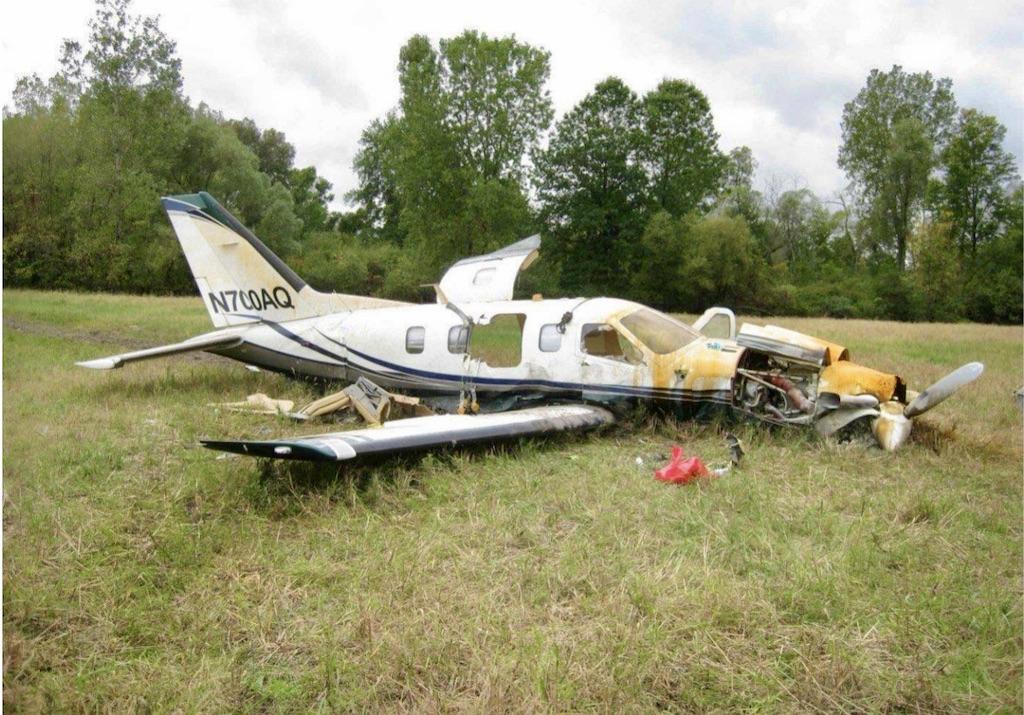
The TBM 700 wreckage. The pilot and four passengers were killed; one passenger survived.
A Daher TBM 700 single-engine turboprop crashed during an attempted go-around from an approach to Capital Region International Airport (LAN) in Lansing, Michigan, on Oct. 3, 2019.
The French BEA report quoted the Pilot Operating Handbook: “The speed range the TBM 700 allows may sometimes lead some experienced pilots to make decelerated approaches with power on IDLE. This type of approach must be conducted sufficiently early in order to ensure a stabilized speed and a torque of not less than 10% before landing (in order to obtain immediately, if required, an increase in power).”
The BEA report provided an explanation of the forces involved in low-speed flight in a forward-mounted, single-engine aircraft, using illustrations. To summarize:
- When the airplane travels at a speed close to that recommended on final (for example 1.3 x Vso), the angle of attack remains significantly below maximum.
- When the pilot increases the power, the effect may be delayed a few seconds. When the engine actually delivers the expected power, the increase in spiral currents causes a yaw movement to the left. As the angle of attack is relatively high, the descending propeller blade (the right-hand blade) exerts a greater pulling force than the rising blade. These two phenomena add to each other. The nose of the aircraft moves to the left, which causes sideslip to the right.
- Lift on the right wing increases and that on the left wing decreases. It sinks slightly, which causes a local increase in the angle of attack. At the same time the effect of an increase in power is to lift the nose of the aircraft, further increasing the angle of attack.
- Finally, the increasing power intensifies the torque effect of the engine, which creates a roll to the left. The left wing sinks again and, during this movement, the angle of attack of this wing also increases.
- When the aircraft banks to the left, the flight path curves to the left. The vertical component of lift no longer balances the weight of the aircraft, which descends in the absence of pitch-up input by the pilot.
- To counteract these movements of the aircraft, the pilot may tend to use the stick to roll to the right instead of acting mainly on the rudder pedals. The left aileron then pushed downward may not be enough to counteract the rolling movement of the aircraft. In parallel, lowering the trailing edge of the aileron modifies the wing profile and increases the angle of attack of this part of the wing. This action has the side-effect of increasing the drag on the left wing.
- The increase in angle of attack of the left wing can go as far as max and lead to a stall. Thus the pilot loses control of his/her aircraft as it banks strongly to the left with a significant nose-down attitude induced before touching the ground.
In addition to the aerodynamic effects described, the report noted that pilots of the TBM 700 may be subject to vestibular disorientation and surprise when confronted with an unusual situation.
Conclusions and Comments
The fact that the BEA found no LOC-I TBM accidents involving professional pilots in commercial or military operations is significant. A search of the NTSB database shows the same thing; there are no examples of TBM LOC-I accidents involving Part 135 operators. The same is also true of the Piper PA46 series of airplanes, which are similar in power and configuration.
TBM models are designed for individuals who want to conduct their private and business travel in a high-performance airplane. The TBMs do not require a type rating (as is required in France), but 14 CFR 61.31 does require training for complex, high-performance, pressurized airplanes, and that training is included in TBM-specific training at SIMCOM.
Unfortunately, just completing a training course at a Part 142 school does not guarantee that a pilot can handle any situation. When a pilot presents himself for training in a high-performance airplane who has minimal qualifications (500 hr. and an instrument rating, for example), he doesn’t suddenly become more experienced when he graduates. His or her learning curve must rise steeply.
The Lansing accident pilot completed SIMCOM training but apparently never completed the 25 hr. of mentoring required by the insurance company. He chose to fly passengers for compensation when he had only a private certificate, and he did it again with a new commercial certificate, but he never had the right to do so as a Part 135 certificate holder.
The NTSB’s probable cause was: “the pilot’s failure to maintain airspeed during final approach, which resulted in a loss of control and an aerodynamic stall at a low altitude, and his decision to operate the airplane outside of the approved weight and balance envelope.”
The probable cause statement is true, but understates how egregious the pilot’s performance was. He held himself out to paying passengers as competent and skillful, and he was not. He flew a rapid deceleration, unstable ILS approach to 400/1.5 mi minimums and lost control when he tried to miss the approach. He was thoroughly unprepared to attempt the flight.
I hope SIMCOM is raising the bar on its graduation requirements and that it incorporates low-speed, high-thrust flight in TBM training. Maybe they will even use the term “torque-induced stall.”
A TBM 700 Experiences A ‘Torque-Induced Stall,’ Part 1:
https://aviationweek.com/business-aviation/safety-ops-regulation/tbm-70…
A TBM 700 Experiences A ‘Torque-Induced Stall,’ Part 2:
https://aviationweek.com/business-aviation/safety-ops-regulation/tbm-70…





